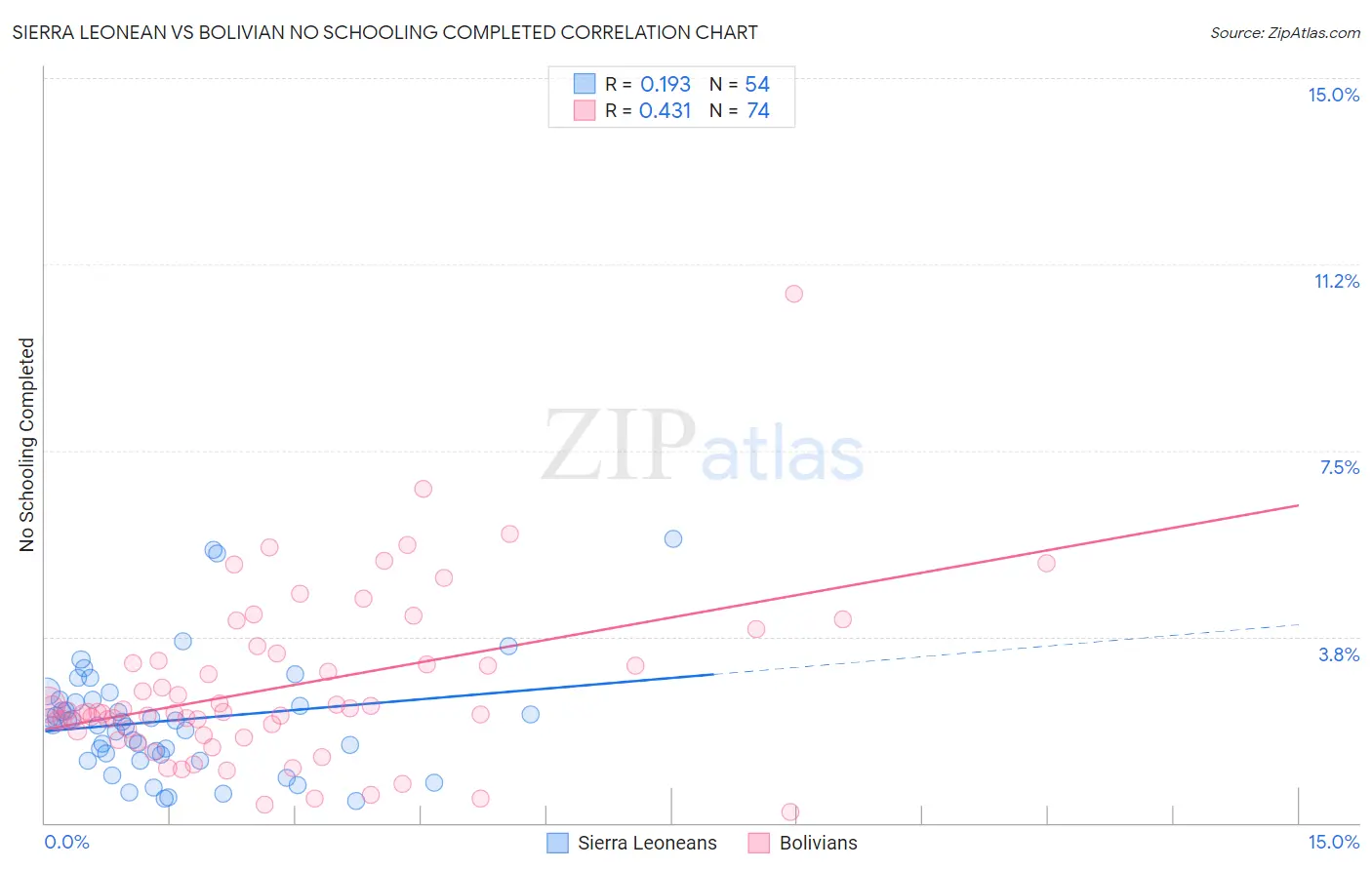Sierra Leonean vs Bolivian No Schooling Completed
COMPARE
Sierra Leonean
Bolivian
No Schooling Completed
No Schooling Completed Comparison
Sierra Leoneans
Bolivians
2.3%
NO SCHOOLING COMPLETED
4.1/ 100
METRIC RATING
226th/ 347
METRIC RANK
2.4%
NO SCHOOLING COMPLETED
1.4/ 100
METRIC RATING
245th/ 347
METRIC RANK
Sierra Leonean vs Bolivian No Schooling Completed Correlation Chart
The statistical analysis conducted on geographies consisting of 83,108,801 people shows a poor positive correlation between the proportion of Sierra Leoneans and percentage of population with no schooling in the United States with a correlation coefficient (R) of 0.193 and weighted average of 2.3%. Similarly, the statistical analysis conducted on geographies consisting of 184,159,099 people shows a moderate positive correlation between the proportion of Bolivians and percentage of population with no schooling in the United States with a correlation coefficient (R) of 0.431 and weighted average of 2.4%, a difference of 3.3%.

No Schooling Completed Correlation Summary
| Measurement | Sierra Leonean | Bolivian |
| Minimum | 0.44% | 0.23% |
| Maximum | 5.7% | 10.7% |
| Range | 5.3% | 10.4% |
| Mean | 2.1% | 2.7% |
| Median | 2.0% | 2.2% |
| Interquartile 25% (IQ1) | 1.4% | 1.8% |
| Interquartile 75% (IQ3) | 2.5% | 3.3% |
| Interquartile Range (IQR) | 1.1% | 1.4% |
| Standard Deviation (Sample) | 1.2% | 1.7% |
| Standard Deviation (Population) | 1.2% | 1.7% |
Demographics Similar to Sierra Leoneans and Bolivians by No Schooling Completed
In terms of no schooling completed, the demographic groups most similar to Sierra Leoneans are Sudanese (2.3%, a difference of 0.010%), Immigrants from Uganda (2.3%, a difference of 0.060%), U.S. Virgin Islander (2.3%, a difference of 0.34%), Immigrants from Pakistan (2.3%, a difference of 0.43%), and Puerto Rican (2.3%, a difference of 0.56%). Similarly, the demographic groups most similar to Bolivians are Peruvian (2.4%, a difference of 0.010%), South American (2.4%, a difference of 0.11%), Immigrants from Indonesia (2.4%, a difference of 0.15%), Korean (2.4%, a difference of 0.47%), and Immigrants from Senegal (2.4%, a difference of 0.53%).
| Demographics | Rating | Rank | No Schooling Completed |
| Sudanese | 4.1 /100 | #225 | Tragic 2.3% |
| Sierra Leoneans | 4.1 /100 | #226 | Tragic 2.3% |
| Immigrants | Uganda | 4.0 /100 | #227 | Tragic 2.3% |
| U.S. Virgin Islanders | 3.7 /100 | #228 | Tragic 2.3% |
| Immigrants | Pakistan | 3.6 /100 | #229 | Tragic 2.3% |
| Puerto Ricans | 3.4 /100 | #230 | Tragic 2.3% |
| Immigrants | Uruguay | 3.4 /100 | #231 | Tragic 2.3% |
| Colombians | 3.2 /100 | #232 | Tragic 2.3% |
| Immigrants | Malaysia | 2.8 /100 | #233 | Tragic 2.3% |
| Nigerians | 2.6 /100 | #234 | Tragic 2.3% |
| Immigrants | Western Asia | 2.6 /100 | #235 | Tragic 2.3% |
| Iraqis | 2.2 /100 | #236 | Tragic 2.4% |
| Immigrants | Eastern Asia | 2.0 /100 | #237 | Tragic 2.4% |
| Paiute | 1.9 /100 | #238 | Tragic 2.4% |
| Liberians | 1.8 /100 | #239 | Tragic 2.4% |
| Immigrants | Senegal | 1.7 /100 | #240 | Tragic 2.4% |
| Koreans | 1.7 /100 | #241 | Tragic 2.4% |
| Immigrants | Indonesia | 1.5 /100 | #242 | Tragic 2.4% |
| South Americans | 1.5 /100 | #243 | Tragic 2.4% |
| Peruvians | 1.4 /100 | #244 | Tragic 2.4% |
| Bolivians | 1.4 /100 | #245 | Tragic 2.4% |